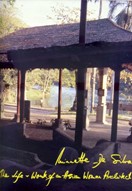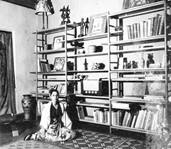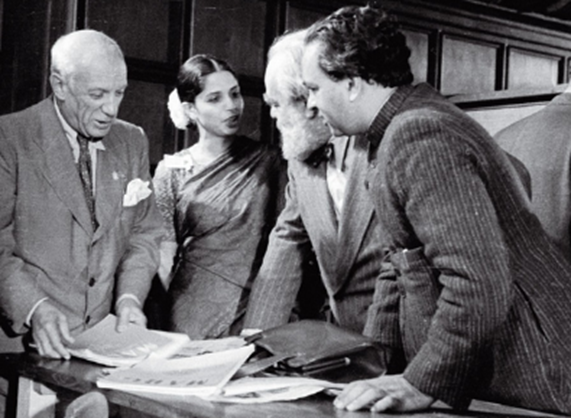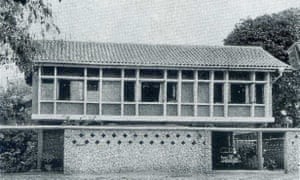Archive
Minnette De Silva
- Minnette
- De Silva
- 01-02-1918
- Kandy (LK)
- 24-11-1998
- Kandy (LK)
- ArchitectJournalist
Probably the first Sri Lankan woman architect and a founding member of Marg, Minnette De Silva mediated between tradition and modernity while defying the boundaries of gender, caste and disciplines.
Word Count: 30

Portrait of Minnette De Silva, around 1945 (© De Silva 1998, 112). 
44.2 Cover of Volume I of Minnette De Silva’s autobiography, 1998 (© De Silva 1998, x). 
Minnette De Silva within a self-designed interior in Ceylon woods, St. George’s, around 1952 (© De Silva 1998, 114). 
Pablo Picasso (left), Minnette De Silva, Jo Davidson and Mulk Raj Anand at the World Congress of Intellectuals in Defense of Peace, 1948 (PAP, Public Domain, via Wikipedia Commons). 
Piries House, Alfred House Gardens, Colomba, 1952−1956 (© De Silva 1998, 182). De Mel, Neloufer. Women & the Nation’s Narrative: Gender and Nationalism in Twentieth Century Sri Lanka. Rowman & Littlefield, 2001.
De Silva, Minnette. The Life & Work of an Asian Woman Architect. Smart Media Productions, 1998.
Dharia, Namita V., and Mary N. Woods. “Women Architects in India: Dreaming through Design.” Marg, vol. 72, no. 1, September 2020, pp. 76–87.
Gupta, Smita. “M.J.P. Mistri – Descendant of Master Builders. An interview with Smita Gupta” Vistāra – The Architecture of India, edited by Carmen Kagal, exh. cat. The Festival of India in U.S.A., 1986, pp. 222–226. Architexturez South Asia, www.architexturez.net/doc/az-cf-123816. Accessed 21 March 2021.
Huppatz, D.J. Modern Asian Design (Cultural histories of design). Bloomsbury Publishing, 2018.
Jayawardena, Kumari. Erasure of the Euro-Asian: Recovering Early Radicalism and Feminism in South Asia. Women Unlimited, 2009.
Lee, Rachel, and Kathleen James-Chakraborty. “Marg Magazine: A Tryst with Architectural Modernity.” ABE Journal, no. 1, May 2012. abe.revues.org, doi: 10.4000/abe.623. Accessed 20 March 2021.
Loomba, Ania. Revolutionary Desires: Women, Communism, and Feminism in India. Routledge, 2019.
Pinto, Shiromi. Plastic Emotions. Influx Press, 2019.
Sales-Pontes, Alzira Hilda. Dr. Mulk Raj Anand – A Critical Bibliography (Doctoral thesis, Loughborough University Of Technology, 1985), www.hdl.handle.net/2134/10854. Accessed 20 March 2021.
Sherlock, Amy. “Born 100 Years Ago, Remembering the ‘Tropical Modernist’ Architect Minnette De Silva.” 11 September 2018, FRIEZE, www.frieze.com/article/born-100-years-ago-remembering-tropical-modernist-architect-minnette-de-silva. Accessed 6 April 2021.
Siddiqi, Anooradha Iyer. “Crafting the Archive: Minnette De Silva, Architecture, and History.” The Journal of Architecture, vol. 22, no. 8, November 2017, pp. 1299–1336. Taylor & Francis Online, doi: 10.1080/13602365.2017.1376341. Accessed 20 March 2021.
Word Count: 240
Marg, Marg Publications, https://marg-art.org/.
Word Count: 6
Many thanks to Ania Loomba, Neloufer De Mel, Shiromi Pinto and Romila Thapar for their support of my research.
Word Count: 19
Sir J.J. College of Art/ Architectural school, 78, Prospect Chambers Annexe, Hornby Road, Fort, Bombay (now 78, Dr Dadabhai Naoroji Rd, Dhobi Talao, Fort, Mumbai) (studio, 1941/1942); 25 Cuffe Parade, Bombay (now 25, Khatau Road, Mumbai) (place of residence and work 1941−c.1945); 15 Savile Row, Mayfair, London W1S 3JN (residence).
- Bombay
- . "Minnette De Silva." METROMOD Archive, 2021, https://archive.metromod.net/viewer.p/69/2951/object/5138-12040707, last modified: 03-01-2024.
-
Mulk Raj AnandWriterPhilosopherArt PatronCultural CriticBombay
As a global socialist and modernist, Mulk Raj Anand sought and shaped opportunities for intellectual exchanges between Asia and Europe.
Word Count: 20
Marg. A Magazine of Architecture and ArtMagazineBombayLocal and exiled creatives formed the Modern Architectural Research Group to publish a progressive journal of art and architecture in Bombay from 1946 onwards.
Word Count: 23
Rudolf von LeydenGeologistAdvertisement SpecialistJournalistArt CriticArt CollectorCartoonistBombayThe advertisement expert, Rudolf von Leyden, became a major art critic and art historian in Bombay in the 1940s, advocating an urgent need for modernism in art in post-colonial India.
Word Count: 30
Homi Jehangir BhabhaScientistCollectorArtistBombayHomi Jehangir Bhabha was a world class scientist, institution builder, an artist and art connoisseur. His vision for growth of science and art has had significant impact in post-colonial India.
Word Count: 30
Farewell Dinner for Walter GropiusDinnerLondonFriends and colleagues came together on 9 March 1937 to send off the architect Walter Gropius and his wife Ise Gropius, who had decided to leave for the United States.
Word Count: 28